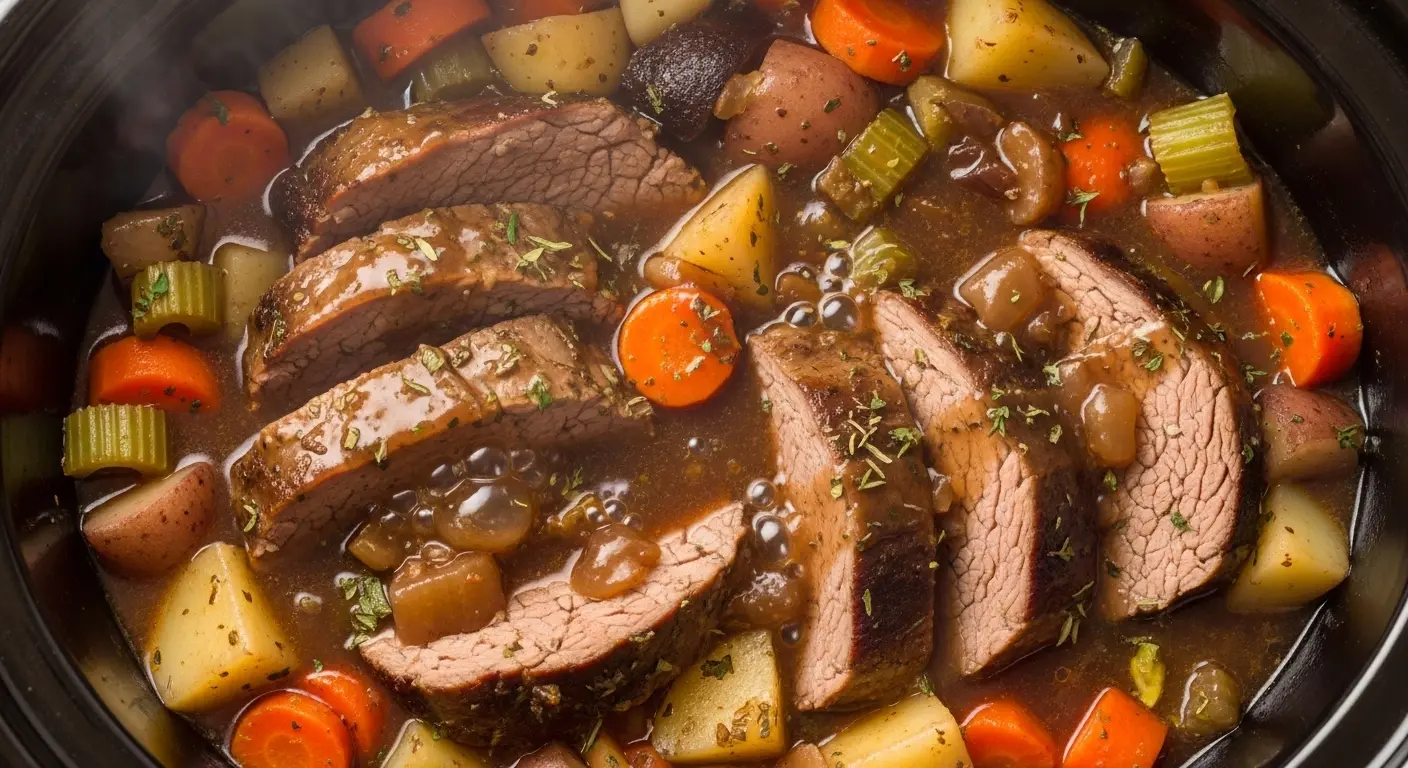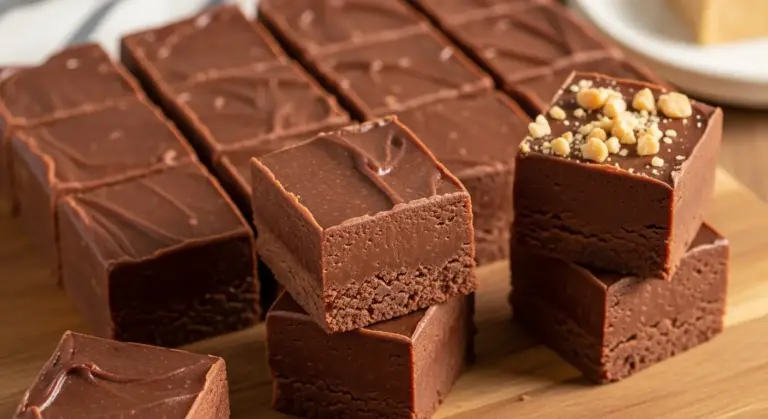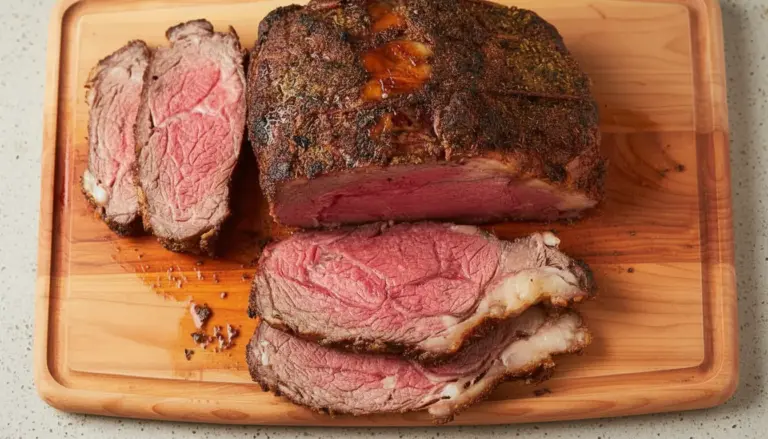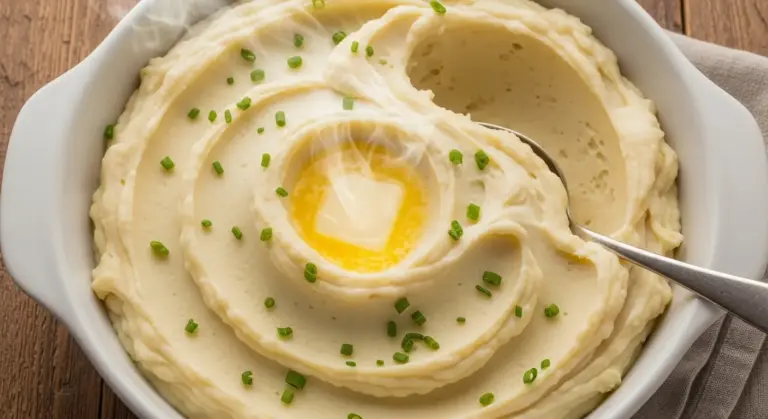I’ll never forget the Sunday my mother-in-law handed me her handwritten recipe card for slow cooker pot roast. It was yellowed with age and splattered with old gravy stains.
At first, I thought it looked too simple to be anything special. But after making it once, I understood why she’d been serving this dish at family gatherings for over thirty years.
This slow cooker pot roast recipe has become my go-to meal when I need dinner to practically cook itself. The meat becomes so tender it falls apart with just a fork, and the vegetables soak up all those rich, savory flavors.
I’ve tweaked the original recipe over the years, adding my own touches and learning from a few kitchen mishaps along the way. Now I’m sharing everything I’ve learned so you can make the most incredible pot roast without spending hours in the kitchen.
| Quick Recipe Summary | |
|---|---|
| Prep Time | 20 minutes |
| Cook Time | 8 hours |
| Total Time | 8 hours 20 minutes |
| Servings | 6-8 servings |
| Difficulty Level | Easy |

Why You’ll Love This Slow Cooker Pot Roast Recipe
This recipe takes all the guesswork out of making pot roast. You don’t need to babysit the stove or worry about burning anything.
The slow cooker does all the heavy lifting while you go about your day. By dinnertime, your house smells absolutely incredible, and you have a complete meal ready to serve.
Here’s what makes this pot roast special:
- Incredibly tender meat: The low and slow cooking method breaks down all the tough fibers in the beef, resulting in meat that literally melts in your mouth
- Foolproof cooking: Unlike oven roasting, you can’t overcook this in the slow cooker (trust me, I’ve tried)
- One-pot meal: Everything cooks together, meaning fewer dishes to wash and better flavor
- Budget-friendly: Chuck roast is an inexpensive cut that transforms into something restaurant-worthy
- Perfect for meal prep: Leftovers taste even better the next day, and the meat shreds beautifully for sandwiches or tacos
- Hands-off cooking: Spend maybe 20 minutes prepping in the morning, then forget about it until dinner
- Deeply flavorful gravy: The cooking liquid becomes a rich, savory gravy that’s perfect over mashed potatoes
I used to make my crockpot beef stew weekly, but this pot roast has become an even bigger family favorite.
Ingredients
The beauty of this recipe is that it uses simple, everyday ingredients that come together to create something truly special. I always keep these items on hand because I know I can throw together an impressive dinner anytime.
Here’s everything you’ll need:
For the Roast:
- 3-4 pounds (1.4-1.8 kg) chuck roast, boneless
- 2 tablespoons olive oil
- 2 teaspoons salt
- 1 teaspoon black pepper
- 1 teaspoon garlic powder
- 1 teaspoon onion powder
- 1/2 teaspoon smoked paprika
For the Vegetables:
- 1 pound (450g) baby potatoes, halved
- 4 large carrots, peeled and cut into 2-inch pieces
- 3 celery stalks, cut into 2-inch pieces
- 1 large yellow onion, cut into wedges
- 6 cloves garlic, smashed
For the Cooking Liquid:
- 2 cups (480ml) beef broth, low-sodium
- 1 cup (240ml) red wine (or additional beef broth)
- 3 tablespoons tomato paste
- 2 tablespoons Worcestershire sauce
- 2 tablespoons balsamic vinegar
- 2 bay leaves
- 4 sprigs fresh thyme (or 1 teaspoon dried)
- 2 sprigs fresh rosemary (or 1/2 teaspoon dried)
For the Gravy (Optional but Recommended):
- 3 tablespoons cornstarch
- 3 tablespoons cold water
- 2 tablespoons butter
Another favorite: Slow Cooker Chili Recipe
Kitchen Equipment Needed
You don’t need fancy equipment for this recipe, but having the right tools makes the process smoother. I’ve learned that investing in a few key pieces makes a huge difference in the final result.
Here’s what you’ll need:
- 6-quart slow cooker: This is the perfect size for a 3-4 pound roast with vegetables. I prefer oval-shaped ones because they accommodate longer roasts better.
- Large skillet: For searing the meat before it goes in the slow cooker. A cast-iron skillet works beautifully for this.
- Sharp chef’s knife: Essential for cutting vegetables and trimming the roast. Dull knives make prep work frustrating and dangerous.
- Cutting board: I use a large wooden one that gives me plenty of space to work.
- Tongs: For turning the roast while searing and handling it once it’s cooked.
- Measuring cups and spoons: Standard measuring tools for getting the liquid ratios right.
- Whisk: If you’re making the gravy, this helps prevent lumps in the cornstarch slurry.
- Ladle: Perfect for serving the gravy over the meat and vegetables.
- Meat thermometer: Not absolutely necessary since slow cooking makes the meat fall-apart tender, but helpful if you want to check doneness.
Read Also: Beef Barley Soup Recipe
Recommended Products for This Recipe
After making this pot roast dozens of times, I’ve found that certain products really do make a difference in the final result. These are my personal recommendations based on what works best in my kitchen.
1. Crock-Pot 7-Quart Programmable Slow Cooker
I upgraded to a programmable slow cooker a few years ago, and it changed my slow-cooking game completely. You can set it to automatically switch to warm mode after cooking, so even if you’re running late, your roast won’t overcook. The digital timer takes all the guesswork out of timing.
2. Lodge Cast Iron Skillet
The searing step is crucial for developing deep flavor, and nothing sears meat like cast iron. This skillet gets screaming hot and creates that beautiful brown crust on the roast. It’s also practically indestructible and will last you a lifetime with proper care.
3. Better Than Bouillon Beef Base
While any beef broth works in this recipe, I’ve found that Better Than Bouillon gives you the most concentrated, beefy flavor. A little jar lasts forever, and you can control the strength of the broth by adjusting how much you use. It adds incredible depth to the gravy.
4. Wusthof Classic Chef’s Knife
A quality chef’s knife makes prep work so much faster and safer. I use mine for everything from cutting vegetables to trimming fat from the roast. It holds its edge beautifully and feels perfectly balanced in your hand.
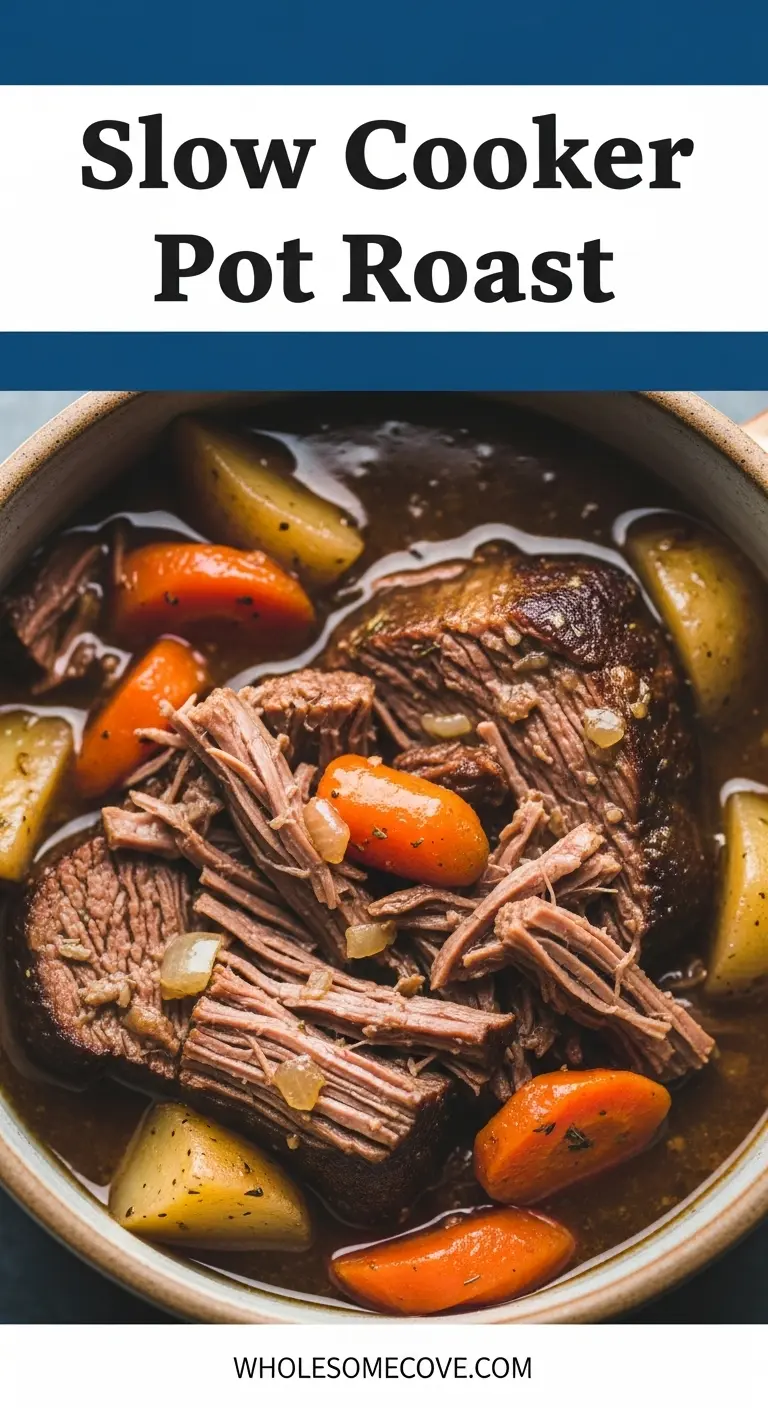
Step-by-Step Instructions: How to Make Slow Cooker Pot Roast
I’m going to walk you through every single step of this process. Even if you’ve never made pot roast before, these detailed instructions will set you up for success.
1. Prepare the Chuck Roast
- Remove the chuck roast from the refrigerator 30 minutes before cooking to bring it to room temperature. This helps it cook more evenly.
- Pat the roast completely dry with paper towels. Any moisture on the surface will prevent proper browning.
- If your roast has thick pockets of fat (more than 1/4 inch), trim them off with a sharp knife. Leave some fat for flavor, but remove excessive amounts.
- In a small bowl, combine the salt, black pepper, garlic powder, onion powder, and smoked paprika to create a seasoning blend.
- Rub the seasoning mixture all over the roast, pressing it into the meat so it adheres well. Don’t be shy here, you want good coverage on all sides.
- Let the seasoned roast sit while you prepare the vegetables. This gives the seasonings time to penetrate the surface.
2. Prep All the Vegetables
- Wash the baby potatoes thoroughly and cut them in half. Try to make the pieces roughly the same size so they cook evenly.
- Peel the carrots and cut them into 2-inch chunks. I angle my knife to create slightly diagonal cuts, which looks prettier in the final dish.
- Trim the celery stalks and cut them into similar-sized pieces as the carrots.
- Peel the onion and cut it into thick wedges, leaving the root end intact so the wedges hold together during cooking.
- Smash the garlic cloves with the flat side of your knife. You don’t need to peel them perfectly, the skins will come off easily after cooking.
- Set all the vegetables aside in a large bowl. Having everything prepped before you start cooking makes the process smooth.
3. Sear the Roast
- Heat a large skillet over medium-high heat and add the olive oil. Let it heat until it shimmers but doesn’t smoke.
- Carefully place the seasoned roast in the hot skillet. You should hear an immediate sizzle.
- Sear the roast for 4-5 minutes on the first side without moving it. This is key to developing a deep brown crust.
- Use tongs to flip the roast and sear each remaining side for 3-4 minutes until deeply browned all over.
- Don’t worry if some of the seasoning sticks to the pan. Those browned bits (called fond) will add tons of flavor to your gravy later.
- Transfer the seared roast to a plate and set aside. Don’t skip the searing step, it’s what creates that rich, meaty flavor.
4. Build the Flavor Base
- Reduce the heat under the skillet to medium and add the smashed garlic cloves. Let them sizzle for about 30 seconds until fragrant.
- Add the tomato paste to the pan and cook it for 1-2 minutes, stirring constantly. This caramelizes the tomato paste and deepens its flavor.
- Pour in the red wine (or additional broth if not using wine) and use a wooden spoon to scrape up all those browned bits from the bottom of the pan.
- Let the wine simmer for 2-3 minutes to cook off the alcohol and reduce slightly.
- Add the beef broth, Worcestershire sauce, and balsamic vinegar to the skillet, stirring to combine everything.
- Bring the mixture to a simmer, then turn off the heat. This is your cooking liquid.
5. Assemble Everything in the Slow Cooker
- Place the onion wedges on the bottom of your slow cooker. They’ll act as a flavorful base for the roast to sit on.
- Arrange the carrots, celery, and potatoes around the edges of the slow cooker.
- Nestle the seared roast right in the center, on top of the onions.
- Tuck the bay leaves, thyme sprigs, and rosemary sprigs around the roast and vegetables.
- Carefully pour the hot cooking liquid over everything. The liquid should come about halfway up the sides of the roast.
- Put the lid on the slow cooker, making sure it’s sealed properly.
6. Slow Cook to Perfection
- Set your slow cooker to low and cook for 8-10 hours, or on high for 5-6 hours. I always choose low for the most tender results.
- Resist the urge to lift the lid during cooking. Every time you peek, you release heat and add 15-20 minutes to the cooking time.
- You’ll know it’s done when the meat is fork-tender and easily shreds when you pull at it with two forks.
- The vegetables should be soft but not mushy. If they’re getting too soft before the meat is ready, you can remove them and set aside.
- The house will smell absolutely incredible after about 4-5 hours. That’s when my family starts hovering in the kitchen.
7. Rest and Slice (or Shred) the Meat
- Once the cooking time is complete, carefully transfer the roast to a cutting board using tongs and a large spatula.
- Let it rest for 10-15 minutes. This allows the juices to redistribute throughout the meat.
- Use two forks to shred the meat into chunks, or slice it against the grain if you prefer. It should be so tender that it practically falls apart on its own.
- Remove and discard the herb sprigs and bay leaves from the slow cooker.
- Use a slotted spoon to transfer the vegetables to a serving platter.
- Keep everything warm while you make the gravy.
8. Make the Rich Gravy
- In a small bowl, whisk together the cornstarch and cold water until completely smooth with no lumps.
- Turn the slow cooker to high. Pour the cornstarch slurry into the cooking liquid, whisking constantly.
- Let the gravy cook for 10-15 minutes, whisking occasionally, until it thickens to your desired consistency.
- Stir in the butter for extra richness and a silky texture.
- Taste the gravy and adjust seasoning with salt and pepper if needed.
- Ladle the gravy over the sliced meat and vegetables before serving.
You might also enjoy: French Onion Beef Short Rib Soup Recipe
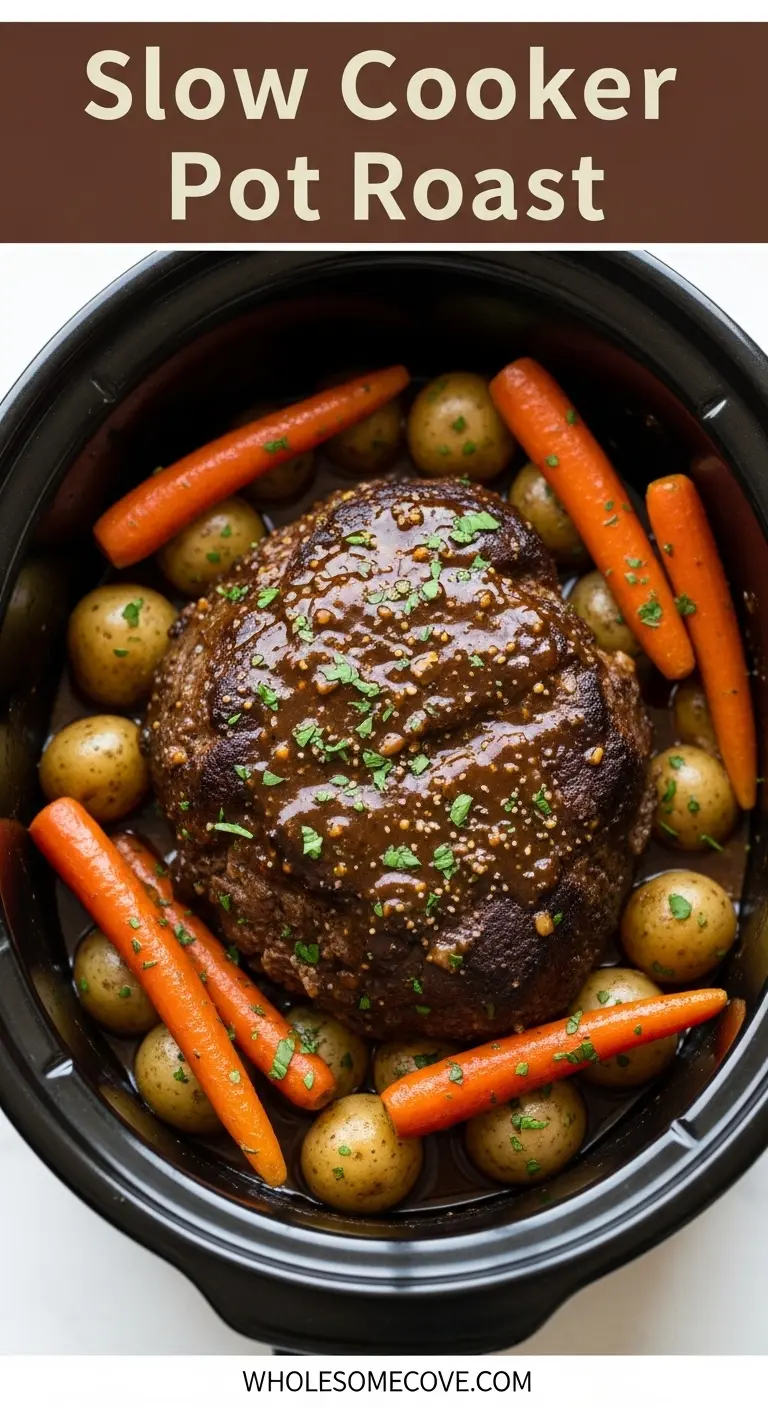
Tips for The Best Slow Cooker Pot Roast
I’ve made this recipe so many times that I’ve picked up several tricks for ensuring perfect results every single time. Here are my most valuable lessons learned.
For the Most Tender Meat:
- Always sear first: That initial browning creates a flavorful crust and adds depth to the entire dish. Don’t skip it even if you’re short on time.
- Choose the right cut: Chuck roast has the perfect balance of fat and connective tissue that breaks down beautifully during slow cooking. Avoid lean cuts like sirloin.
- Cook low and slow: Low heat for a longer time produces much more tender meat than high heat. Patience pays off here.
- Don’t trim all the fat: Some marbling throughout the roast keeps it moist and adds flavor. Just remove thick external fat layers.
- Let it rest: Those 10-15 minutes after cooking allow the juices to settle back into the meat fibers.
For the Best Flavor:
- Use good quality broth: The cooking liquid becomes your gravy, so use the best broth you can afford. Homemade is ideal if you have it.
- Don’t skip the wine: It adds incredible depth and complexity. If you don’t cook with alcohol, use additional broth plus a splash of balsamic vinegar.
- Layer your aromatics: Placing onions on the bottom and herbs around the meat ensures even flavor distribution.
- Season generously: The meat needs bold seasoning since it dilutes slightly during the long cooking time.
- Save those pan drippings: All those browned bits in your searing pan are pure flavor. Deglaze properly and get every bit into the slow cooker.
For Perfect Vegetables:
- Cut uniformly: Same-sized pieces cook at the same rate, preventing some from being mushy while others are undercooked.
- Place strategically: Harder vegetables like carrots go on the bottom where it’s hottest. More delicate items can go on top.
- Don’t overcrowd: If your slow cooker is small, reduce the vegetable amounts or cook them separately.
- Add timing considerations: If you prefer firmer vegetables, add them during the last 3-4 hours of cooking instead of at the beginning.
Common Mistakes to Avoid:
- Opening the lid too often: Every peek adds cooking time and releases moisture. Trust the process.
- Using too much liquid: You only need enough to come halfway up the roast. Too much dilutes the flavor.
- Cutting vegetables too small: Tiny pieces will turn to mush. Stick with larger, hearty chunks.
- Not deglazing the pan: Those browned bits are where so much flavor lives. Get them all.
- Forgetting to thicken the gravy: The cooking liquid is thin until you add cornstarch. Don’t serve it as-is.
Read Also: Meatloaf Recipe
Serving Suggestions
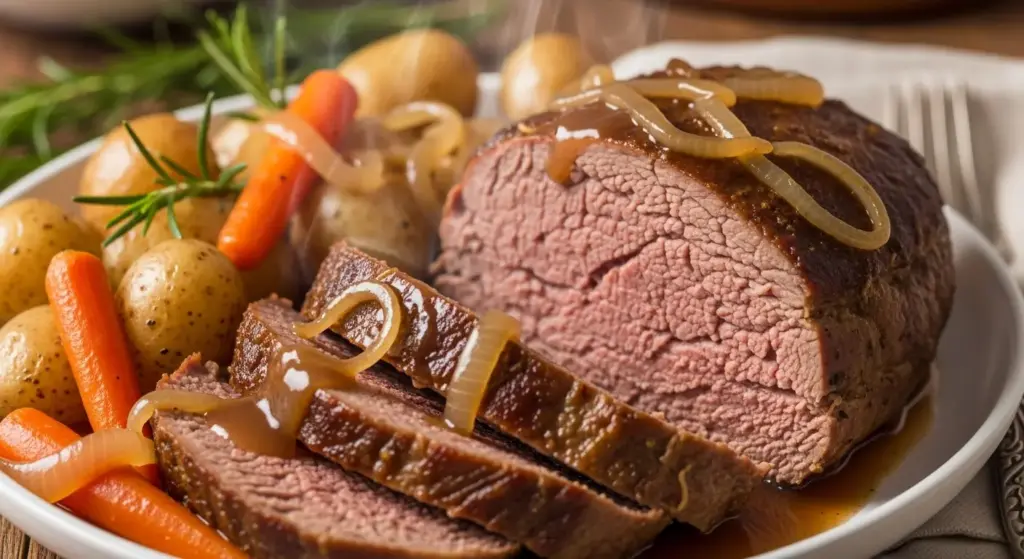
This pot roast is incredibly versatile and pairs beautifully with so many different sides. The rich gravy works wonderfully over almost anything starchy.
The roast and vegetables are hearty enough to serve on their own, but I love rounding out the meal with some complementary sides. Here are my favorite ways to serve it:
- Classic mashed potatoes: The creamy texture is perfect for soaking up all that delicious gravy
- Buttered egg noodles: Simple and comforting, they let the roast be the star of the show
- Crusty bread rolls: Essential for mopping up every last drop of gravy from your plate
- Roasted Brussels Sprouts with Bacon: Adds a nice crispy texture contrast to the tender meat
- Simple green salad: A fresh, acidic salad cuts through the richness beautifully
- Creamy Coleslaw: The tangy crunch complements the tender, savory roast perfectly
- Dinner rolls or Jiffy Spoon Bread: Great for soaking up the gravy
- Steamed green beans: A lighter vegetable option that doesn’t compete with the hearty main dish
- Garlic bread: Because you can never have too much bread when there’s gravy involved
- Roasted root vegetables: If you want more vegetables beyond what’s already in the pot
For drinks, I love serving this with a full-bodied red wine like Cabernet Sauvignon or Malbec. The wine’s tannins complement the rich, fatty meat beautifully.
Read Also: Sloppy Joe Recipe
Variations of Slow Cooker Pot Roast
Once you master the basic recipe, it’s fun to experiment with different flavor profiles. I’ve tried dozens of variations over the years, and these are my favorites.
Mississippi Pot Roast:
- Add one packet of ranch seasoning mix and one packet of au jus gravy mix to the slow cooker
- Top the roast with 5-6 pepperoncini peppers and a stick of butter
- Proceed with the recipe as written
- This creates an incredibly rich, tangy, slightly spicy roast that’s become wildly popular
Italian-Style Pot Roast:
- Replace the thyme and rosemary with Italian seasoning
- Add 1 can (14 oz) of diced tomatoes with their juice
- Include sliced bell peppers with the vegetables
- Substitute red wine vinegar for balsamic
- Serve over polenta or pasta instead of potatoes
French-Inspired Pot Roast:
- Use a full bottle of red wine instead of mixed liquids (reduce beef broth to 1/2 cup)
- Add pearl onions and mushrooms during the last 2 hours
- Include more thyme and a strip of orange peel
- Finish with a splash of cognac if you’re feeling fancy
- This version is similar to boeuf bourguignon but easier
Asian-Fusion Pot Roast:
- Replace Worcestershire with soy sauce
- Add 2 tablespoons of hoisin sauce and 1 tablespoon of grated fresh ginger
- Include star anise and a cinnamon stick with the aromatics
- Use shiitake mushrooms and bok choy instead of traditional vegetables
- Serve over rice or noodles
BBQ Pot Roast:
- Add 1 cup of your favorite BBQ sauce to the cooking liquid
- Include smoked paprika in the seasoning blend
- Add a tablespoon of liquid smoke for extra smokiness
- Serve the shredded meat on toasted buns with coleslaw
Herb-Crusted Pot Roast:
- Double the amount of fresh herbs
- Add fresh sage and oregano to the mix
- Rub the herbs directly on the meat before searing
- Use white wine instead of red for a lighter flavor profile
Mexican-Spiced Pot Roast:
- Add cumin, chili powder, and oregano to the seasoning blend
- Include chipotle peppers in adobo sauce in the cooking liquid
- Use beef broth only (no wine)
- Serve the shredded meat in tacos or burrito bowls with fresh cilantro
Another favorite: Filet Mignon Recipe
Storage and Reheating
This pot roast stores beautifully, and many people think it tastes even better the next day after the flavors have had time to meld. I actually make extra on purpose for leftovers.
Storing in the Refrigerator:
- Let the pot roast cool to room temperature before storing (but don’t leave it out longer than 2 hours)
- Transfer the meat, vegetables, and gravy to separate airtight containers for easier reheating
- Store in the refrigerator for up to 4 days
- Keep the gravy separate because it thickens considerably when cold
- If the fat solidifies on top of the gravy, you can easily scrape it off before reheating
Freezing for Later:
- This recipe freezes beautifully for up to 3 months
- Let everything cool completely before freezing
- Use freezer-safe containers or heavy-duty freezer bags
- Remove as much air as possible to prevent freezer burn
- Label containers with the date and contents
- Freeze the meat and gravy together for best results
- The potatoes don’t freeze as well, so I often freeze just the meat and make fresh vegetables later
Reheating Methods:
- In the oven: Place meat and vegetables in a baking dish, cover with foil, and heat at 325°F (165°C) for 20-30 minutes
- On the stovetop: Add everything to a large pot with a splash of broth, cover, and heat over medium-low until warmed through
- In the microwave: Use a microwave-safe dish, cover, and heat in 2-minute increments, stirring between each
- In the slow cooker: Add everything back to the slow cooker with a bit of extra liquid and heat on low for 2-3 hours
- For frozen pot roast: Thaw overnight in the refrigerator before reheating for best texture
Creative Ways to Use Leftovers:
- Shred the meat for pot roast sandwiches on toasted hoagie rolls
- Make shepherd’s pie by topping the meat and vegetables with mashed potatoes and baking
- Add to beef barley soup for extra heartiness
- Use in breakfast hash with fried eggs
- Stuff into baked potatoes with cheese and sour cream
- Make pot roast tacos or quesadillas
- Turn it into pot roast poutine with fries, cheese curds, and gravy
- Mix into pasta with the gravy as sauce
You might also enjoy: Brunswick Stew Recipe

Nutritional Facts
This nutritional information is approximate and based on one serving (assuming 8 servings from the entire recipe). The actual values will vary based on the exact cut of meat, how much fat you trim, and whether you consume all the gravy.
Per Serving (approximately):
- Calories: 420
- Total Fat: 18g
- Saturated Fat: 6g
- Trans Fat: 0g
- Cholesterol: 125mg
- Sodium: 680mg
- Total Carbohydrates: 22g
- Dietary Fiber: 3g
- Sugars: 5g
- Protein: 42g
- Vitamin A: 120% DV
- Vitamin C: 25% DV
- Calcium: 6% DV
- Iron: 30% DV
- Potassium: 18% DV
Nutritional Highlights: The chuck roast provides high-quality protein essential for muscle maintenance and repair. The carrots contribute significant vitamin A for eye health and immune function.
Potatoes offer resistant starch and potassium, which supports healthy blood pressure. The beef also provides important B vitamins, particularly B12, which is only found in animal products.
While this dish is relatively high in calories and fat, it’s a complete, balanced meal when you consider that it includes protein, vegetables, and complex carbohydrates all in one dish. The fat content can be reduced by trimming more aggressively before cooking and skimming fat from the gravy.
If you’re watching sodium, use low-sodium broth and reduce the added salt in the seasoning blend. You can also reduce the Worcestershire sauce, which contributes sodium.
Read Also: Lasagna Recipe
Health Benefits of Key Ingredients
While pot roast is definitely comfort food, it’s actually packed with nutrients that benefit your health. This isn’t just delicious food, it’s nourishing too.
Chuck Roast (Beef): Chuck roast is an excellent source of complete protein containing all nine essential amino acids your body needs. It’s particularly rich in iron, which helps transport oxygen throughout your body and prevents anemia.
The beef also provides zinc for immune function, B vitamins for energy metabolism, and selenium for antioxidant protection. Grass-fed beef contains higher levels of omega-3 fatty acids and conjugated linoleic acid, which have anti-inflammatory properties.
Carrots: These vibrant vegetables are loaded with beta-carotene, which your body converts to vitamin A. This supports healthy vision, skin, and immune function.
Carrots also contain antioxidants that may reduce the risk of certain cancers. The fiber in carrots aids digestion and helps maintain healthy cholesterol levels.
Potatoes: Despite their reputation, potatoes are actually quite nutritious. They’re rich in vitamin C, potassium, and vitamin B6.
The resistant starch in potatoes feeds beneficial gut bacteria and may improve insulin sensitivity. When eaten with the skin, they provide valuable dietary fiber that promotes digestive health.
Onions and Garlic: Both contain powerful sulfur compounds that have anti-inflammatory and antimicrobial properties. Garlic has been shown to support cardiovascular health by helping to lower blood pressure and cholesterol.
Onions provide quercetin, an antioxidant that may reduce inflammation and support immune function. These aromatics also contain prebiotics that feed healthy gut bacteria.
Celery: This crunchy vegetable is extremely low in calories but provides important antioxidants and anti-inflammatory compounds. It contains vitamin K for bone health and potassium for blood pressure regulation.
Celery also provides beneficial plant compounds that may protect against oxidative stress and chronic disease.
Red Wine (if using): In moderation, red wine contributes beneficial compounds like resveratrol, which has antioxidant properties. The wine adds depth of flavor while providing minimal calories once the alcohol cooks off.
If you don’t use alcohol, the antioxidant benefits can be partially replicated with additional balsamic vinegar.
Fresh Herbs (Thyme, Rosemary): These aren’t just for flavor. Rosemary contains compounds that may improve digestion and enhance memory and concentration.
Thyme has antimicrobial properties and provides vitamins C and A. Both herbs contain antioxidants that fight free radical damage in the body.
FAQs About Slow Cooker Pot Roast
1. Can I make this pot roast without searing the meat first?
Technically yes, you can skip the searing step and the meat will still be tender and edible. However, I strongly recommend against it because searing creates a flavorful crust through the Maillard reaction.
Those browned bits add tremendous depth to the final dish that you simply can’t replicate any other way. The extra 10 minutes spent searing makes a huge difference in the overall flavor profile of your pot roast and gravy.
2. What’s the best cut of meat for slow cooker pot roast?
Chuck roast is hands-down the best choice for pot roast. It has the perfect balance of fat, connective tissue, and muscle that breaks down beautifully during slow cooking.
Other good options include bottom round roast or rump roast, though these are leaner and may be slightly less tender. Avoid expensive cuts like tenderloin or sirloin, they’re better suited for quick cooking methods and will actually become dry and stringy in the slow cooker.
3. Why is my pot roast tough and dry?
This usually happens when the roast hasn’t cooked long enough. Chuck roast needs that full 8-10 hours on low to properly break down all the connective tissue.
If you cooked it on high for too short a time, it can paradoxically be both overcooked and tough. Another common cause is using too lean a cut of meat, which doesn’t have enough fat to stay moist during long cooking.
4. Can I add the vegetables at a different time?
Absolutely, and I often do this when I want firmer vegetables. If you add them at the beginning, they’ll be very soft after 8-10 hours.
For firmer vegetables, add them during the last 3-4 hours of cooking on low (or last 2 hours on high). This way they’ll be cooked through but retain more texture and structure.
5. How do I make the gravy thicker or thinner?
For thicker gravy, make an additional cornstarch slurry (1-2 tablespoons cornstarch mixed with equal parts cold water) and whisk it into the simmering liquid. Let it cook for another 10 minutes to thicken.
For thinner gravy, simply whisk in additional beef broth or water until you reach your desired consistency. You can also reduce the amount of cornstarch in the original recipe if you prefer a thinner, more au jus style sauce.
Read Also: Chicken Parmesan Recipe
Final Thoughts
This slow cooker pot roast recipe has been a lifesaver for me on countless busy weekdays. There’s something deeply satisfying about coming home to a house filled with the aroma of this incredible meal.
The tender, fall-apart meat and perfectly cooked vegetables in that rich gravy create comfort food at its finest. I hope this recipe becomes as beloved in your kitchen as it is in mine.
Don’t hesitate to make it your own by trying different variations or adjusting the vegetables to suit your family’s preferences. The beauty of slow cooking is its forgiving nature.
I’d love to hear how your pot roast turns out! Leave a comment below with your experience, any tweaks you made, or questions you have. And if you loved this recipe, please share it with friends who could use an easy, delicious dinner solution.
Recommended:
- Stuffed Shells Recipe
- Taco Casserole Recipe
- Cheeseburger Soup Recipe
- Chicken Adobo Recipe
- Chicken Spaghetti Recipe
- Lasagna Soup Recipe
- Marinara Sauce Recipe
- Best Sausage Tortellini Soup Recipe
- Creamy Tomato Basil Soup Recipe
- Apple Cider Glazed Pork Chops Recipe

